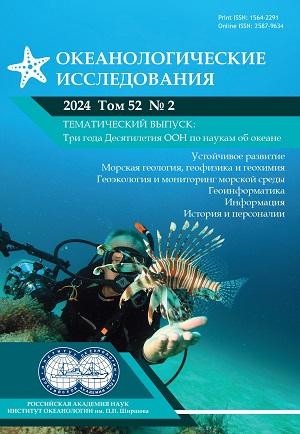ИЗМЕНЧИВОСТЬ ВОДНЫХ МАСС ПРОЛИВА БРАНСФИЛД ПО ДАННЫМ НАБЛЮДЕНИЙ ААНИИ 2016–2022 гг.
Аннотация
В статье представлены результаты анализа данных глубоководных океанологических наблюдений, проводившихся учеными ААНИИ в проливе Брансфилд с 2016 г. по 2022 г. Пролив Брансфилд отличается сложной динамикой, уникальными водными массами, высокой биопродуктивностью. Выполненные ранее исследования позволили составить представление о структуре и характеристиках водных масс, циркуляции вод, особенностях ледового режима. В настоящее время на фоне наблюдаемых изменений климата актуальным является мониторинг изменений состояния вод океана. Основные наблюдения судами ААНИИ проводятся на регулярно повторяющемся разрезе через центральную котловину пролива Брансфилд, от залива Максуэлл до материкового склона Антарктического полуострова. Ряд наблюдений состоит из шести реализаций разреза с дискретностью 1 год. Наблюдения на разрезе через восточную котловину пролива проводились дважды – в 2018 г. и 2022 г. Установлены существенные различия в характеристиках и динамике водных масс пролива между реализациями повторяющихся разрезов. Температура и соленость придонного слоя Глубинной воды пролива Брансфилд (ГВБ), заполняющей абиссаль центральной котловины, изменялась в пределах от –1.578 до –1.797 °С и от 34.555 до 34.598 епс соответственно. Тенденция на потепление более, чем на 0.2 °С (до –1.578 °С) и опреснение на 0.03 епс (до 34.555 епс), наблюдавшаяся в период 2018–2020 гг., нарушена новым похолоданием на 0.2 °С (до –1.747 °С) и ростом солености до 34.593 епс за год. Установлена изменчивость характеристик течения пролива Брансфилд (ТПБ), проявившаяся в колебаниях горизонтального (от 10 до 20 км) и вертикального (от 200 до 550 м) размеров потока. Спорадически появляющийся язык глубинной воды из Антарктического циркумполярного течения ниже потока ТПБ зафиксирован только в данных, полученных в 2020–2022 гг. В этот период характеристики ядра показали заметную изменчивость глубины залегания ядра (в диапазоне 320–450 м), температуры (от 0.460 до 0.891 °С) и солености (34.582–34.612 епс). Разрез через восточную котловину пролива позволил обнаружить повышение за 4 года средней температуры слоя ГВБ мощностью 1200 м на 0.25 °С (с сопутствующим ростом солености на 0.02 епс).
Литература
- Антипов Н. Н., Бунякин В. П., Кашин С. В., Кузнецов В. Л., Чистяков И. А. Океанографические исследования Южного океана в январе–апреле 2016 года с борта НЭС «Академик Федоров» // Российские полярные исследования. 2016. № 2. С. 12–15.
- Антипов Н. Н., Бунякин В. П., Кашин С. В., Кузнецов В. Л., Чистяков И. А. Океанографические исследования Южного океана в 41-м рейсе НЭС «Академик Федоров» // Российские полярные исследования. 2017. № 3. С. 8–10.
- Антипов Н. Н., Кашин С. В., Молчанов М. С. Глубоководные океанологические исследования Южного океана с борта НЭС «Академик Трешников» в сезонный период 66-й РАЭ // Российские полярные исследования. 2021. № 3. С. 9–13.
- Антипов Н. Н., Кашин С. В., Молчанов М. С., Федотова А. А. Основные результаты океанологических исследований Южного океана в сезонный период 67-й РАЭ // Российские полярные исследования. 2022. № 4. С. 18–24.
- Антипов Н. Н., Кашин С. В., Молчанов М. С. Океанографические исследования Южного океана в 14-м рейсе НЭС «Академик Трешников» // Российские полярные исследования. 2020. № 2. С. 32–35.
- Кречик В. А., Фрей Д. И., Морозов Е. Г. Особенности циркуляции вод в центральной части пролива Брансфилда в январе 2020 г. // Доклады Российской Академии наук. Науки о Земле. 2021. Т. 496. № 1. С. 101–105.
- Морозов Е. Г. Течения в проливе Брансфилд // Доклады Академии наук. 2007. Т. 415. №6. С. 823–825.
- Мухаметьянов Р. З., Фрей Д. И., Морозов Е. Г. Течения в проливе Брансфилда по геострофическим расчетам и данным инструментальных измерений // Известия РАН. Физика атмосферы и океана. 2022. Т. 58. № 5. С. 583–590.
- Caspel Van M., Hellmer H. H., Mata M. M. On the ventilation of Bransfield Strait deep basins // Deep-Sea Res. II. 2017. Vol. 149. P. 25–30. https://doi.org/10.1016/j.dsr2.2017.09.006.
- Damià Gomis, Marc A. Garcı́a, Oswaldo López, Ananda Pascual Quasi-geostrophic 3D circulation and mass transport in the western Bransfield Strait during Austral summer 1995/96// Deep Sea Research. Part II: Topical Studies in Oceanography. 2002. Vol. 49. No. 4–5. P.603–621. https://doi.org/10.1016/S0967-0645(01)00114-X.
- Dotto T. S., Kerr R., Mata M. M., Garcia C. A. E. Multidecadal freshening and lightening in the deep waters of the Bransfield Strait, Antarctica // J. Geophys. Res.: Oceans. 2016. Vol. 121. P.3741–3756. https://doi.org/10.1002/2015JC011228.
- Frey D. I., Krechik V. A., Morozov E. G., Drozd I. D., Gordey A. S., Latushkin A. A., MekhovaO.S., Mukhametianov R. Z., Murzina S. A., Ostroumova S. A. et al. Water Exchange between Deep Basins of the Bransfield Strait // Water. 2022. Vol. 14. 3193. https://doi.org/10.3390/w14203193.
- Garcı́a M. A., Castro C. G., Rı́os A. F., Doval M. D., Rosón G., Gomis D., López O. Water masses and distribution of physico-chemical properties in the Western Bransfield Strait and Gerlache Strait during Austral summer 1995/96 // Deep Sea Research. Part II: Topical Studies in Oceanography. 2002. Vol. 49. No. 4–5. 2002. P. 585–602. https://doi.org/10.1016/S0967-0645(01)00113-8.
- Gordey A. S., Frey D., Drozd I., Krechik V., Smirnova D. A., Gladyshev S., MorozovE. Spatial variability of water mass transports in the Bransfield Strait based on direct current measurements// Deep Sea Research. Part I: Oceanographic Research Papers. 2024. Vol. 207. 104284. https://doi.org/10.1016/j.dsr.2024.104284.
- Gordon A. L., Mensch M., Zhaoqian D., Smethie W. M. Jr., de Bettencourt J. Deep and bottom water of the Bransfield strait eastern and central basins // J. Geophys. Res.: Oceans. 2000. Vol.105. P. 11337–11346. https://doi:10.1029/2000JC900030.
- Gordon A. L., Nowlin W. D. The Basin Waters of the Bransfield Strait // J. Phys. Oceanogr. 1978. Vol. 8. P. 258–264. https://doi.org/10.1175/1520-0485(1978)008<0258:TBWOTB>2.0.CO;2.
- Heywood K. J., Naveira Garabato A. C., Stevens D. P., Muench R. D. On the fate of the Antarctic Slope Front and the origin of the Weddell Front // J. Geophys. Res.: Oceans. 2004. Vol. 109. C06021. https://doi.org/10.1029/2003JC002053.
- Hirano D., Kitade Y., Ohshima K. I., Fukamachi Y. The role of turbulent mixing in the modified Shelf Water overflows that produce Cape Darnley Bottom Wate // J. Geophys. Res.: Oceans, 2015. Vol. 120. P. 910–922. https://doi.org/10.1002/2014JC010059.
- Hofmann E. E., Klinck J. M., Lascara C. M., Smith D. A. Water Mass Distribution and Circulation West of the Antarctic Peninsula And Including Bransfield Strait // Foundations for Ecological Research West of the Antarctic Peninsula. 2002. P. 61–80. https://doi.org/10.1029/AR070p0061.
- Huhn O., Hellmer H. H., Rhein M., Rodehacke C., Roether W., Schodlok M. P., SchröderM. Evidence of deep- and bottom-water formation in the western Weddell Sea // Deep Sea Res. PartII: Top. Stud. Oceanogr. 2008. Vol. 55. P. 1098–1116. https://doi.org/10.1016/j.dsr2.2007.12.015.
- Jackett D. R., McDougall T. J. A neutral density variable for the world’s oceans // J. Phys. Oceanogr. 1997. Vol. 27. P. 237–263.
- López O., Garcı́a M. A., Gomis D., Rojas P., Sospedra J., Sánchez-Arcilla A. Hydrographic and hydrodynamic characteristics of the eastern basin of the Bransfield Strait (Antarctica) // Deep Sea Research. Part I: Oceanographic Research Papers. 1999. Vol. 46. No. 10. P. 1755–1778. https://doi.org/10.1016/S0967-0637(99)00017-5.
- McDougall T. J. Neutral surfaces // J. Phys. Oceanogr. 1987. Vol. 17. P. 1950–1964.
- Mathias van Caspel, Hartmut H. Hellmer, Mauricio M. Mata On the ventilation of Bransfield Strait deep basins // Deep Sea Research. Part II: Topical Studies in Oceanography. 2018. Vol.149. P. 25–30. https://doi.org/10.1016/j.dsr2.2017.09.006.
- Meng Zhou, Pearn P. Niiler, Yiwu Zhu, Ryan D. Dorland The western boundary current in the Bransfield Strait, Antarctica // Deep Sea Research. Part I: Oceanographic Research Papers. 2006. Vol. 53. No. 7. P. 1244–1252. https://doi.org/10.1016/j.dsr.2006.04.003.
- Orsi A. H., Johnson G. C., Bullister J. L. Circulation, mixing, and production of Antarctic bottom water // Prog. Oceanogr. 1999. Vol. 43. P. 55–109.
- Poulin F., Stegner A., Hern M., Marrero-Díaz A., Sangrá P. Steep Shelf Stabilization of the Coastal Bransfield Current: Linear Stability Analysis // J. Phys. Oceanogr. 2014. Vol. 44 (2). P.714–732. https://doi.org/10.1175/JPO-D-13-0158.1.
- Sangrà P., Gordo C., Hernández-Arencibia M., Marrero-Díaz A., Rodríguez-Santana A., Stegner A., Martínez-Marrero A., Pelegrí J. L., Pichon T. The Bransfield Current System // Deep Sea Research. Part I: Oceanographic Research Papers. 2011. Vol. 58. No. 4. P. 390–402. https://doi.org/10.1016/j.dsr.2011.01.011.
- Strass V. H., Rohardt G., Kanzow T., Hoppema M., Boebel O. Multidecadal Warming and Density Loss in the Deep Weddell Sea, Antarctica // J. Climate. Vol. 33. P. 9863–9881. https://doi.org/10.1175/JCLI-D-20-0271.1.
- Tokarczyk R. Classification of water masses in the Bransfield Strait and Southern part of the Drake Passage using a method of statistical multidimensional analysis // Polish Polar Research. 1987. Vol. 8. P. 333–336.
- Whitworth T., Nowlin W. D., Orsi A. H., Locarnini R. A., Smith S. G. Weddell Sea shelf water in the Bransfield Strait and Weddell-Scotia Confluence // Deep Sea Research. Part I: Oceanographic Research Papers. 1994. Vol. 41. No. 4. P. 629–641. https://doi.org/10.1016/0967-0637(94)90046-9.
- Whitworth III T., Orsi A. H., Kim S.-J., Nowlin W. D., Locarnini R. A. Water masses and mixing near Antarctic Slope Front // Ocean, Ice and Atmosphere: Interactions at the Antarctic Continental Margin. Antarctic Res. Ser. 1998. Vol. 75. P. 1–27.
Передача авторских прав происходит на основании лицензионного договора между Автором и Федеральным государственным бюджетным учреждением науки Институт океанологии им. П.П. Ширшова Российской академии наук (ИО РАН)













